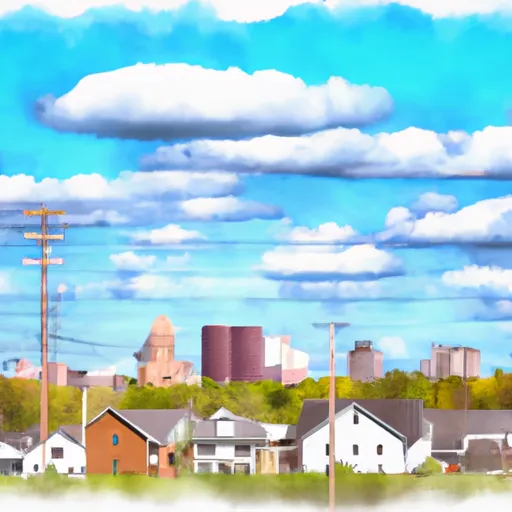-
 Snoflo Premium
Snoflo Premium
Get unlimited access to all our content
With no Ad interruptions! - Start Your Free Trial Login with existing account
Puposky
Eden Index
Climate
4.8
•
Recreation
1.7
•
Community
•
Safeguard
2.5/10

Puposky is a small unincorporated community located in Beltrami County, Minnesota. Situated in the northern part of the state, Puposky experiences a continental climate, characterized by cold winters and warm summers. Average temperatures range from lows of around 0°F (-18°C) in winter to highs of approximately 80°F (27°C) in summer. The area receives an average of 30 inches of precipitation per year, with snowfall being common during the winter months.
As for hydrology, Puposky is surrounded by numerous lakes, including Upper Red Lake, which is one of Minnesota's largest inland lakes. This provides ample opportunities for water-based activities such as fishing, boating, and swimming. The region is also dotted with smaller lakes and rivers, attracting outdoor enthusiasts for canoeing, kayaking, and wildlife observation.
Outdoor recreation opportunities in Puposky are abundant. The surrounding forests and natural areas offer opportunities for hiking, camping, and birdwatching. Hunters can enjoy pursuing game such as deer and waterfowl during the appropriate seasons. In winter, residents and visitors can engage in activities like snowmobiling, cross-country skiing, and ice fishing.
Overall, Puposky offers a picturesque environment for those seeking to enjoy the beauty of Minnesota's outdoors throughout the year.
What is the Eden Index?
The Snoflo Eden Index serves as a comprehensive rating system for regions, evaluating their desirability through a holistic assessment of climate health, outdoor recreation opportunities, and natural disaster risk, acknowledging the profound impact of these factors on livability and well-being.
Climate Health Indicator (CHI): 4.8
Puposky receives approximately
621mm of rain per year,
with humidity levels near 82%
and air temperatures averaging around
4°C.
Puposky has a plant hardyness factor of
3, meaning
plants and agriculture in this region thrive during a short period during spring and early summer. Most
plants will die off during the colder winter months.
By considering the ideal temperature range, reliable water supplies, clean air, and stable seasonal rain or snowpacks, the Climate Health Indicator (CHI) underscores the significance of a healthy climate as the foundation for quality living.
A healthy climate is paramount for ensuring a high quality of life and livability in a region, fostering both physical well-being and environmental harmony. This can be characterized by ideal temperatures, reliable access to water supplies, clean air, and consistent seasonal rain or snowpacks.
Weather Forecast
Streamflow Conditions
Lower Red
Area Rivers
Lower Red
Snowpack Depths
Lower Red
Reservoir Storage Capacity
Lower Red
Groundwater Levels
Recreational Opportunity Index (ROI): 1.7
The Recreational Opportunity Index (ROI) recognizes the value of outdoor recreational options, such as parks, hiking trails, camping sites, and fishing spots, while acknowledging that climate plays a pivotal role in ensuring the comfort and consistency of these experiences.
Access to outdoor recreational opportunities, encompassing activities such as parks, hiking, camping, and fishing, is crucial for overall well-being, and the climate plays a pivotal role in enabling and enhancing these experiences, ensuring that individuals can engage in nature-based activities comfortably and consistently.
Camping Areas
| Campground | Campsites | Reservations | Toilets | Showers | Elevation |
|---|---|---|---|---|---|
| Williams City Park | 25 | 1,158 ft | |||
| Knob Hill | None | 1,288 ft | |||
| Huntersville Township | None | 1,378 ft | |||
| Huntersville Forest Landing - Huntersville State Forest | 24 | 1,349 ft | |||
| Mantrap - Paul Bunyan State Forest | 40 | 1,527 ft | |||
| Mantrap Lake - Paul Bunyan State Forest | 38 | 1,531 ft | |||
| Andersons Crossing | None | 1,353 ft | |||
| Memorial Forest Park - Menahga | 24 | 1,396 ft | |||
| Frames Landing Campsite | None | 1,326 ft | |||
| Shell City Landing - Huntersville State Forest | 35 | 1,432 ft |
Catastrophe Safeguard Index (CSI):
The Catastrophe Safeguard Index (CSI) recognizes that natural disaster risk, encompassing floods, fires, hurricanes, and tornadoes, can drastically affect safety and the overall appeal of an area.
The level of natural disaster risk in a region significantly affects safety and the overall livability, with climate change amplifying these risks by potentially increasing the frequency and intensity of events like floods, fires, hurricanes, and tornadoes, thereby posing substantial challenges to community resilience and well-being.
Community Resilience Indicator (CRI):
The Community Resilience Indicator (CRI) recognizes that education, healthcare, and socioeconomics are crucial to the well-being of a region. The CRI acknowledges the profound impact of these elements on residents' overall quality of life. By evaluating educational resources, healthcare accessibility, and economic inclusivity, the index captures the essential aspects that contribute to a thriving community, fostering resident satisfaction, equity, and social cohesion.

